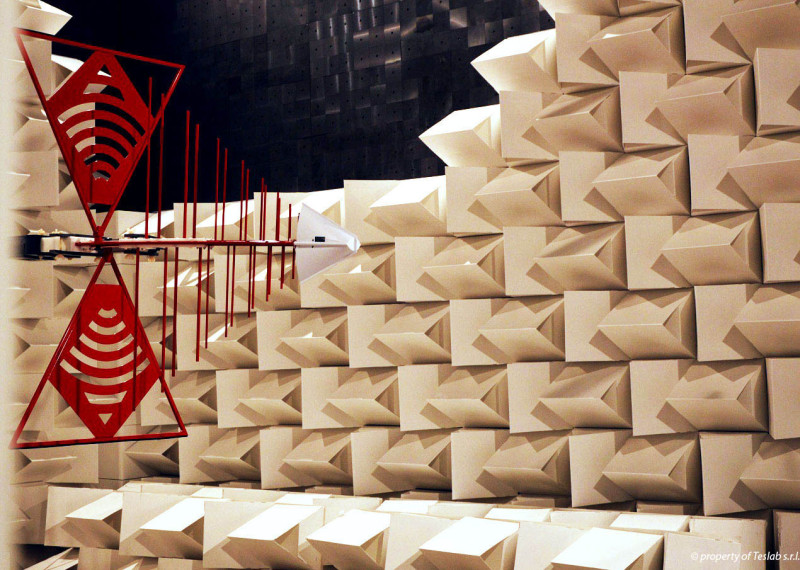Electromagnetic Compatibility

The term “Electromagnetic Compatibility” (abbreviated as EMC), defines the field of electrical engineering that studies the involuntary generation, propagation and reception of electromagnetic energy that can cause undesired effects, such as electromagnetic interference (EMI) or damage to devices. The objective of the EMC is the proper operation of the different equipment in a common electromagnetic environment
EMC (Electromagnetic Compatibility)
It consists in verifying that the disturbances emitted by the device under test are lower than the limits imposed by regulations applicable to the product itself. The purpose of this type of test is to avoid other devices from being disturbed, or from interfering with radio communications in the assigned bands.
EMI (Electromagnetic Immunity)
The Electromagnetic Compatibility (EMC) Laboratory has all the equipment necessary to perform a wide range of FULL COMPLIANCE tests that go well beyond the normal tests required by Directive 2014/30/UE . All instrumentation strumentazione is subject to periodic calibration referable to nationally recognised samples according to the ISO 17025 standard..
The purpose of the Electromagnetic Compatibility tests is to verify the suitability of an apparatus to operate in its electromagnetic environment in a satisfactory manner without deterioration in the presence of electromagnetic disturbanceand without producing unacceptable electromagnetic disturbances in other equipment in the same environment.
-
Conducted Emissions measurement
Verification of the level of electromagnetic disturbance generated by the device under test and connected to power, telecommunication or I/O networks.
-
Radiated Emissions measurement
Verification of the level of electromagnetic disturbance generated by the device under test and radiated into the surrounding environment.
-
Harmonic Current measurement
Verification of the emission level of the harmonic current injected on the supply lines
-
Flicker Noise Emissions
It aims at verifying voltage variations, voltage fluctuations and flicker in low voltage power supply systems.
-
Conducted Immunity test
It aims at testing the level of immunity to disturbances originating from power, telecommunication or I/O networks.
-
Radio Frequency Radiated Immunity test
It aims at testing the level of immunity to radio frequency disturbances radiated in the surrounding environment.
-
Burst Noise Immunity test
It aims at testing the level of immunity to high frequency repetition disturbances.
-
Surge Disturbance Immunity test
It aims at testing the level of immunity to unidirectional peaks caused by switching and transient overvoltage due to lightning strikes.
-
ESD Disturbance Immunity test
It aims at testing the level of immunity to electrostatic discharge due to direct or indirect user contact.
-
Magnetic Fields Immunity test
It aims at testing the level of immunity to magnetic fields at a 50 or 60 Hz network frequency.
-
Voltage Variations Immunity
It aims at testing the level of immunity to changes in power supply voltage.

-
Cispr 16-2-1
Specification for radio interference and immunity apparatus and measurement methods
Part 2-1: Measurement methods of disturbances and immunity – Measurements of conducted disturbances
-
Cispr 16-2-2
Specification for radio interference and immunity apparatus and measurement methods
Part 2-2: Measurement methods of disturbances and immunity – Measurement of disturbing power
-
Cispr 16-2-3
Specification for radio interference and immunity apparatus and measurement method
Part 2-3: Radio interference and immunity measurement methods – Measurement of irradiated disturbances
-
EN 55011
Industrial, scientific and medical devices (ISM) – Radio disturbance characteristics – Limits and methods of measurement
-
EN 55015
Limits and methods of measurement of radio interference characteristics of electrical lighting equipment and similar equipment
-
EN 55022
Information technology equipment – Radio disturbance characteristics – Limits and methods of measurement
-
EN 55025
Information technology equipment – Radio disturbance characteristics – Limits and methods of measurement
-
EN 60945
Maritime navigation and radio communication equipment and systems General requirements – Methods of testing and required test results
-
EN 61000-3-2
Electromagnetic compatibility (EMC)- Part 3-2: Limits – Limits for harmonic current emissions (Equipment input current up to and including 16 A per phase)
-
EN 61000-3-3
Electromagnetic compatibility (EMC)- Part 3: Limits – Section 3: Limitation of voltage fluctuations and flicker in low voltage supply systems for equipment with rated current ≤ 16 A
-
MIL-STD 461
Department of defense interface standard Requirements for the control of electromagnetic interference characteristics of subsystems and equipment
-
RTCA DO 160
Environmental conditions and test procedures for airborne equipment
-
EN 61000-4-2
Electromagnetic compatibility (EMC) Part 4: Testing and measurement techniques Section 2: Electrostatic discharge immunity test Basic EMC pubblication
-
EN 61000-4-3
Electromagnetic compatibility (EMC) Part 4-3: Testing and measurement techniques Radiated, radio-frequency, electromagnetic field immunity test
-
EN 61000-4-4
Electromagnetic compatibility (EMC) Part 4-4: Testing and measurement techniques – Electrical fast transient/burst immunity test
-
EN 61000-4-5
Electromagnetic compatibility (EMC) Part 4-5: Testing and measurement techniques Surge immunity test
-
EN 61000-4-6
Electromagnetic compatibility (EMC) Part 4-6: Testing and measurement techniques Immunity to conducted disturbances,induced by radio-frequency fields
-
EN 61000-4-7
Electromagnetic compatibility (EMC) Part 4-7: Testing and measurement techniques General guide on harmonics and interharmonics measurements and instrumentation, for power supply systems and equipment connected
-
EN 61000-4-8
Electromagnetic compatibility (EMC) Part 4-8: Testing and measurement techniques Power frequency magnetic field immunity test
-
EN 61000-4-9
Electromagnetic compatibility (EMC) Part 4-9: Testing and measurement techniques Pulse magnetic field immunity test
-
EN 61000-4-11
Electromagnetic compatibility (EMC) Part 4-11: Testing and measurement techniques – Voltage dips, short interruptions and voltage variations immunity test
-
EN 61000-4-12
Electromagnetic compatibility (EMC) Part 4-12: Testing and measurement techniques Oscillatory waves immunity test
-
Normative ISO
-
Normative Automotive